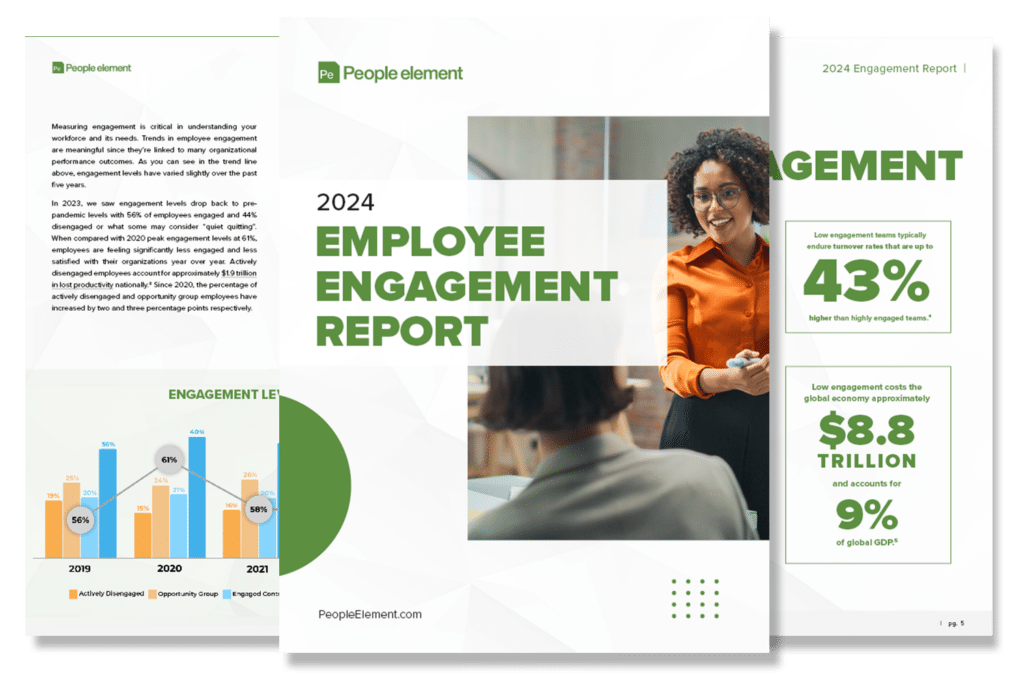Today’s business climate is unpredictable, and the issue of employee retention seems to be never-ending. Regardless of the unique business challenges we face, there’s one central element to how we survive and thrive, and that’s our people. As Josh Bersin recently noted “Employees are not labor or ‘tools’ to be used. They are the core, lifeblood, and source of all value in your company. If you treat them as tools, they break, leave, or hold your organization back.”
Listening Creates Value
Listening to your employees gives them a chance to voice their thoughts and opinions and share valuable insights. Giving them a voice is a great way to make them feel heard and valued in their workplace.
Exit Interviews have become common for collecting feedback from departing employees, but are you asking and listening to the ones who are staying?
For these employees, now is the time to ask them for feedback, listen to what they are experiencing, and find out what you can do to address issues they may be facing. One proven approach to addressing retention is with Stay Interviews or surveys.
What is a Stay Interview?
Stay Interviews can be a useful feedback tool to gather information from your employees that have been with the organization for a while. By soliciting feedback from this group of employees, you can gain insights into what makes them engaged and content but also uncover leading indicators of issues that may cause employees to leave in the future if not addressed. Stay Interviews serve a different purpose than Onboarding and Exit Interviews. Stay Interviews are intended for those employees that have been at the company for a while, have experienced the culture, and are not on the way out the door.
Approaches To Stay Interviews
Traditional One-on-One Interviews
One of the most traditional approaches to conducting stay interviews is to have managers meet one-on-one with their employees and ask them questions. Managers are a go-to option because they should already be having regular check-ins with their people, building relationships, and encouraging open dialogue about what’s working and what’s not. Managers can add stay questions into their regular check-ins, but it is important to keep performance evaluations and discussions separate. In this format, the quality of the data is dependent on the manager listening and accurately recording feedback while refraining from influencing or dominating the conversation.
Some challenges associated with this format:
- Manager’s time and availability can be a constraint
- Inconsistency of questions being asked
- Managers not refraining from judgment or bias during interviews
- Employee not feeling safe enough to speak candidly
HR Leader conducting one-on-one interviews
A similar alternative to manager-conducted stay interviews is having an HR leader conduct them instead. Many in HR can serve as a confidential feedback loop between the manager and/or organization and the employee. This can help HR build relationships and learn how to better support employee needs and organizational development needs. While this approach can save managers time, there will still be time constraints around scheduling and conducting these interviews. There will always be a challenge of objectivity with internal interviewers, and employees may still feel uncomfortable sharing open and honest feedback.
Stay Surveys
Incorporating stay surveys can provide organizations with greater benefits over the one-on-one approach. Stay surveys allow your people added safety and time to process their thoughts and feelings, without worrying about how a person might react. This approach ensures the right questions are consistently asked across employees. Feedback is collected quickly with little impact on internal time and resources. Leveraging multiple communication channels can help you gather more feedback with email, SMS, and phone options.
Feedback collected consistently in one system provides a holistic view of your people, while allowing managers and HR to assess the risk of attrition and understand individual barriers to success. A challenge to surveys is that they don’t provide a human connection. If managers don’t follow up on feedback provided, surveys won’t be as effective and can create distrust among employees.
Third-Party Interviews
A happy medium between in-house one-on-one interviews and stay surveys is third-party live phone interviews. This format provides a human touch and removes the risk of bias and judgment from the interviewer. Employees can be more willing to share their feelings and experiences without fear of internal reactions or retaliation. This approach can help people feel safe to speak openly and candidly. Professional interviewers are trained to dig deep and ask follow-up questions without judgment or asking leading questions. This leads to more rich and accurate responses from your workforce. External interviews save valuable time and resources by taking the responsibility off the shoulders of managers or HR leaders.
Action Matters
Regardless of how you collect the feedback, follow-up is critical to success. If managers and leaders wait too long to act and employees don’t see changes based on their feedback, the interviews can have a negative impact on the organization.
Practical Use Cases
When is the right time or scenario to deploy a stay interview? There are many great opportunities to ask your employees for feedback throughout their time with your organization. You don’t want to wait until it’s too late to try. A few examples include:
- Tenure milestones
- Times of high turnover
- Signals from exit interview insights
- Hard-to-Fill positions
Tenure Milestones
Employee milestones can be a good indicator of when it is time to run a stay interview. Employment anniversaries are a great trigger or reminder that it is time for that individual to participate in a stay interview or fill out a survey. Depending on how often you want to ask stay questions, you could deploy annually on their anniversary date.
Additional tenure milestones could include when an employee moves into a new position within the organization, takes on additional responsibilities, or if there is a significant change in their role. These could all be integral times to check in and note any changes in their stay attitudes.
A practical example of a tenure-based stay interview is within a company that offers signing bonuses. Say the bonus was paid out incrementally, with the last installment being after 24 months. If they notice that the biggest spikes in turnover are happening when employees reach their 26th month, they could conduct stay interviews at 22 months. This way, they have a chance to understand what is going on and how they can adjust to get ahead of the turnover.
Times of High Turnover Rates
The example above illustrates the use of a tenure milestone coupled with a time of high turnover. High turnover rates can be an indicator that a stay interview is needed to get more information on what could be causing employees to leave. To leverage this, look for times when the most turnover occurs and strategically place a stay interview before it. Asking stay questions before employees make the decision to leave will give insight into what specific factors are contributing to them staying at the organization.
Signals from Exit Interview Feedback
Exit Interviews can provide real insight into potential risk areas that you want to get ahead of before more people leave. Monitor exit feedback regularly to look for anomalies, significant changes in the data, or a decrease in favorability across groups. This can provide a signal to gather stay feedback from others impacted who haven’t left yet. While it is important to know what is not working, it is equally important to learn what is working to nurture those initiatives and replicate them in other areas.
Hard-to-Fill Positions
No matter what industry, it can be hard to fill certain positions either due to the type of work, skills needed, or high market demand. Stay interviews can be used to ask current employees in those roles for their thoughts on how to improve the position or what they enjoy most about it. Learning first-hand from employees and giving them a voice to share their experiences is a win-win situation. These insights can then be used to help attract new employees and keep the current ones engaged.
Key Takeaways
- Give your people a voice early and often
- Don’t wait until exit interviews to start the conversation
- Listen to understand, not just to respond
- Find the right format and approach that works for you and your people
- Be strategic about timing
- Communicate your plans
- Act on feedback & make informed decisions





